Research Project: Gender Equality in Leadership at Next plc
VerifiedAdded on 2023/01/11
|27
|5654
|91
Report
AI Summary
This research project examines the significance of gender equality in leadership and management for organizational success, using Next plc as a case study. The study includes a literature review exploring the importance of managing equality, negative impacts of gender inequality, and strategies for maintaining gender equality. The methodology incorporates both qualitative and quantitative approaches, utilizing a research onion framework and a deductive research approach. Data collection methods include primary and secondary sources, with a focus on questionnaires administered to a sample of Next plc employees. The research aims to identify the needs and importance of managing equality, the negative impacts of gender inequality, and strategies Next plc can adopt to ensure a positive and efficient workplace. The report covers various aspects of the research, including the research philosophy, approach, methods, and instruments used for data collection, providing a comprehensive analysis of gender equality in leadership within the organization.
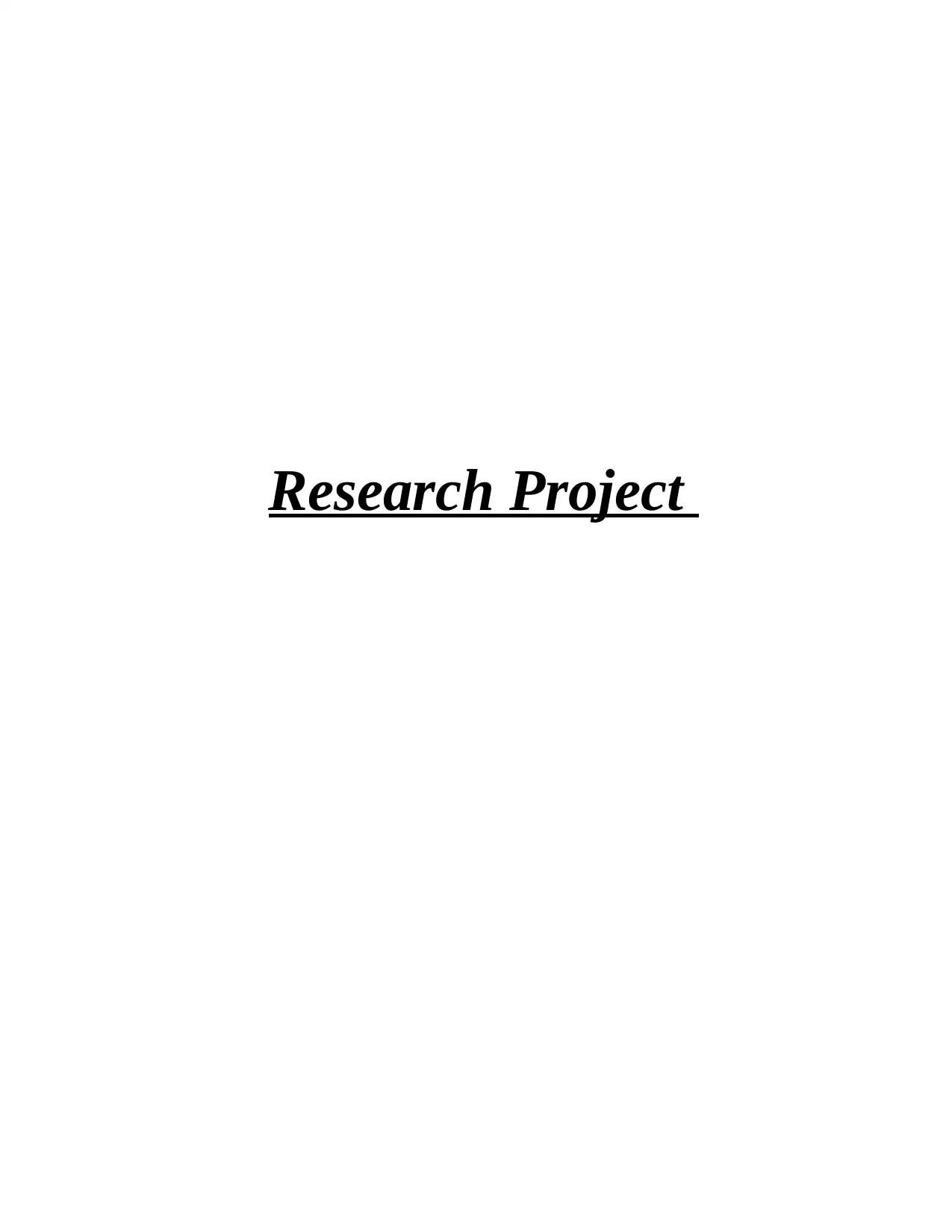
Research Project
Paraphrase This Document
Need a fresh take? Get an instant paraphrase of this document with our AI Paraphraser
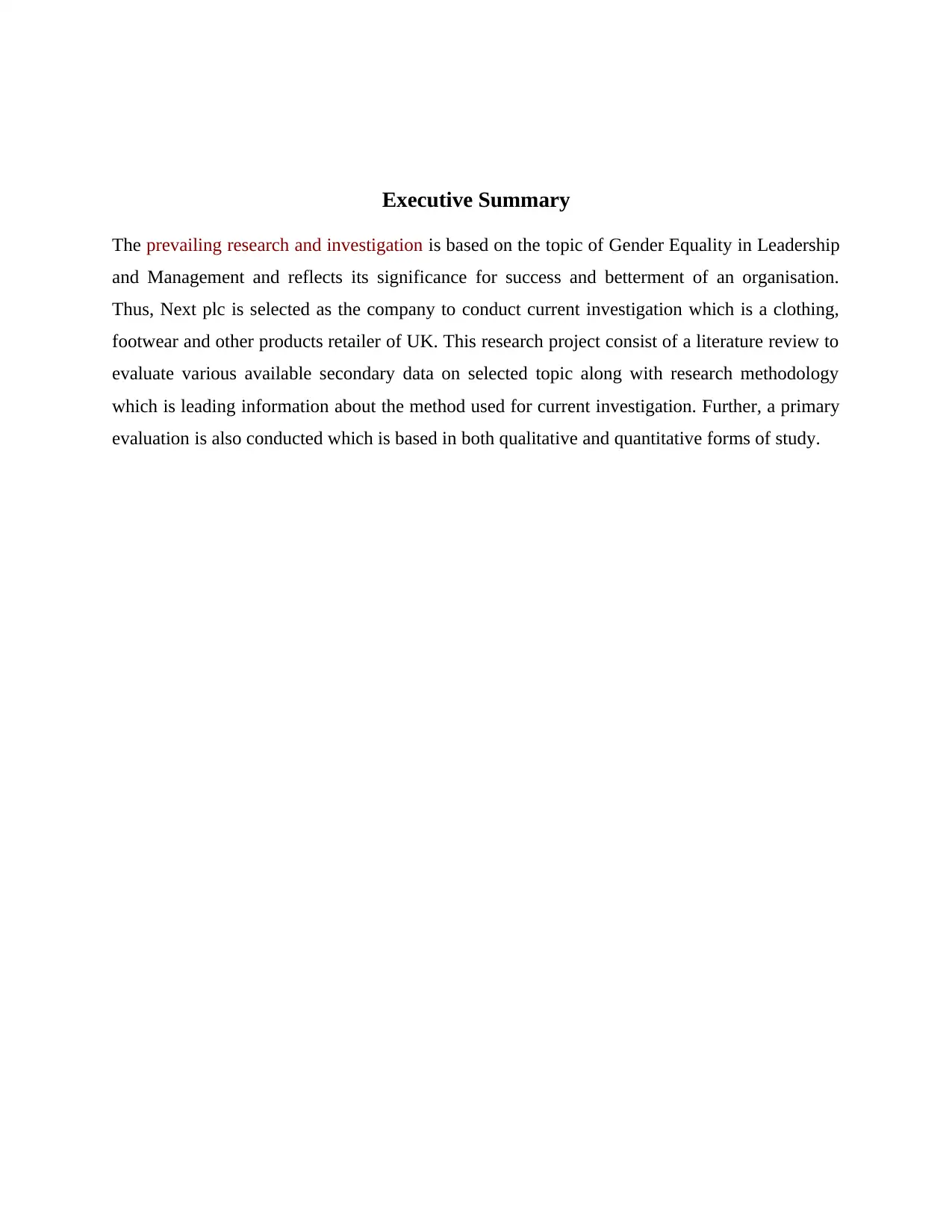
Executive Summary
The prevailing research and investigation is based on the topic of Gender Equality in Leadership
and Management and reflects its significance for success and betterment of an organisation.
Thus, Next plc is selected as the company to conduct current investigation which is a clothing,
footwear and other products retailer of UK. This research project consist of a literature review to
evaluate various available secondary data on selected topic along with research methodology
which is leading information about the method used for current investigation. Further, a primary
evaluation is also conducted which is based in both qualitative and quantitative forms of study.
The prevailing research and investigation is based on the topic of Gender Equality in Leadership
and Management and reflects its significance for success and betterment of an organisation.
Thus, Next plc is selected as the company to conduct current investigation which is a clothing,
footwear and other products retailer of UK. This research project consist of a literature review to
evaluate various available secondary data on selected topic along with research methodology
which is leading information about the method used for current investigation. Further, a primary
evaluation is also conducted which is based in both qualitative and quantitative forms of study.
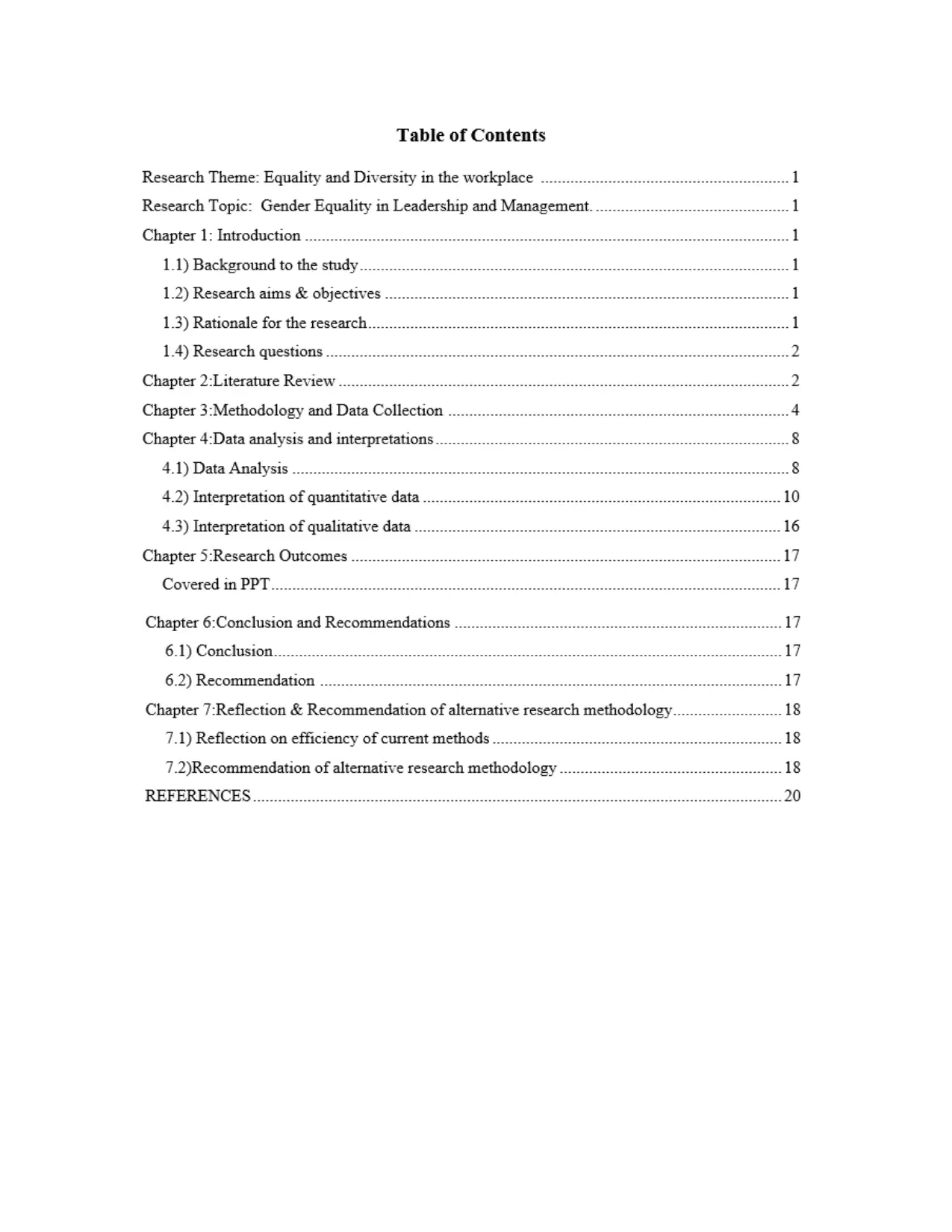
⊘ This is a preview!⊘
Do you want full access?
Subscribe today to unlock all pages.

Trusted by 1+ million students worldwide

Paraphrase This Document
Need a fresh take? Get an instant paraphrase of this document with our AI Paraphraser
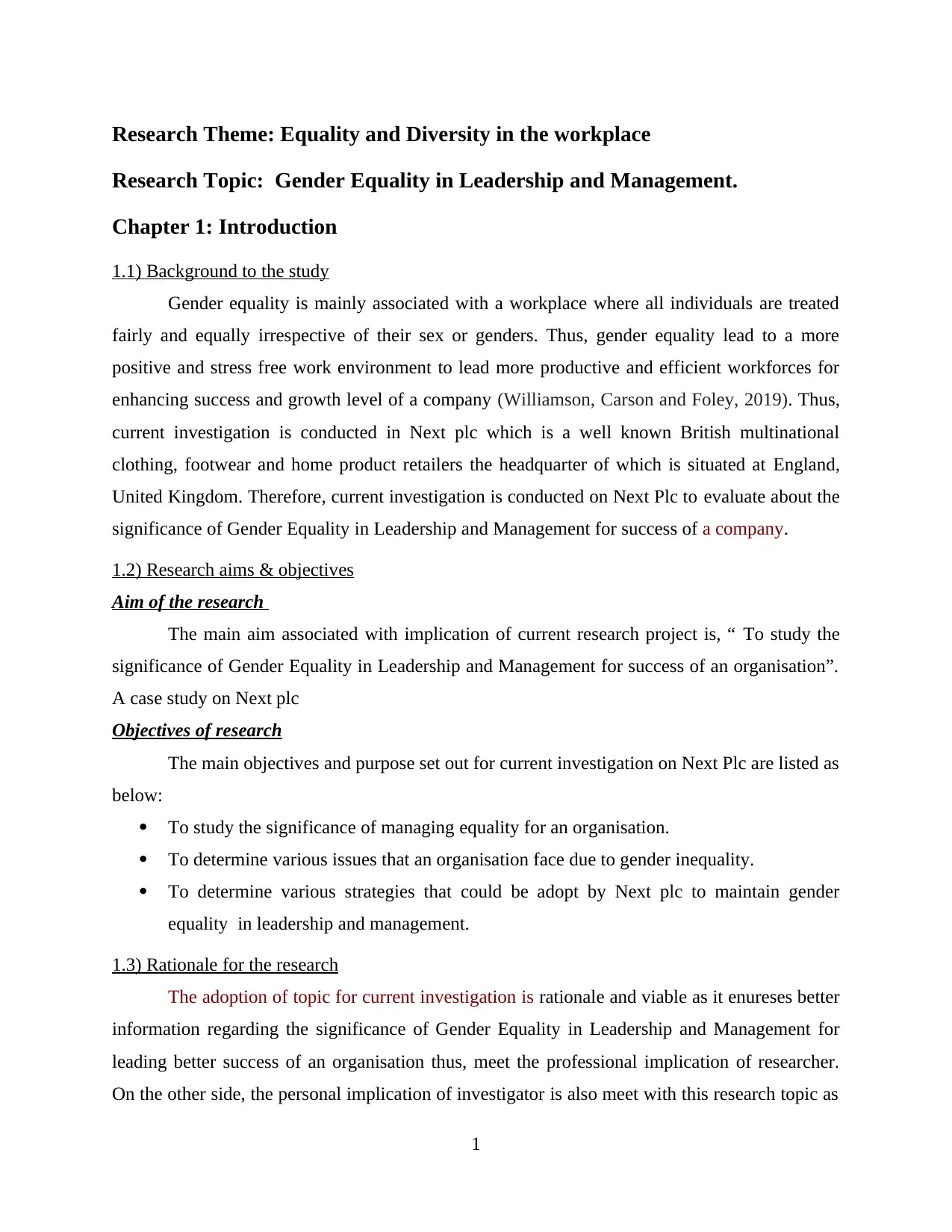
Research Theme: Equality and Diversity in the workplace
Research Topic: Gender Equality in Leadership and Management.
Chapter 1: Introduction
1.1) Background to the study
Gender equality is mainly associated with a workplace where all individuals are treated
fairly and equally irrespective of their sex or genders. Thus, gender equality lead to a more
positive and stress free work environment to lead more productive and efficient workforces for
enhancing success and growth level of a company (Williamson, Carson and Foley, 2019). Thus,
current investigation is conducted in Next plc which is a well known British multinational
clothing, footwear and home product retailers the headquarter of which is situated at England,
United Kingdom. Therefore, current investigation is conducted on Next Plc to evaluate about the
significance of Gender Equality in Leadership and Management for success of a company.
1.2) Research aims & objectives
Aim of the research
The main aim associated with implication of current research project is, “ To study the
significance of Gender Equality in Leadership and Management for success of an organisation”.
A case study on Next plc
Objectives of research
The main objectives and purpose set out for current investigation on Next Plc are listed as
below:
To study the significance of managing equality for an organisation.
To determine various issues that an organisation face due to gender inequality.
To determine various strategies that could be adopt by Next plc to maintain gender
equality in leadership and management.
1.3) Rationale for the research
The adoption of topic for current investigation is rationale and viable as it enureses better
information regarding the significance of Gender Equality in Leadership and Management for
leading better success of an organisation thus, meet the professional implication of researcher.
On the other side, the personal implication of investigator is also meet with this research topic as
1
Research Topic: Gender Equality in Leadership and Management.
Chapter 1: Introduction
1.1) Background to the study
Gender equality is mainly associated with a workplace where all individuals are treated
fairly and equally irrespective of their sex or genders. Thus, gender equality lead to a more
positive and stress free work environment to lead more productive and efficient workforces for
enhancing success and growth level of a company (Williamson, Carson and Foley, 2019). Thus,
current investigation is conducted in Next plc which is a well known British multinational
clothing, footwear and home product retailers the headquarter of which is situated at England,
United Kingdom. Therefore, current investigation is conducted on Next Plc to evaluate about the
significance of Gender Equality in Leadership and Management for success of a company.
1.2) Research aims & objectives
Aim of the research
The main aim associated with implication of current research project is, “ To study the
significance of Gender Equality in Leadership and Management for success of an organisation”.
A case study on Next plc
Objectives of research
The main objectives and purpose set out for current investigation on Next Plc are listed as
below:
To study the significance of managing equality for an organisation.
To determine various issues that an organisation face due to gender inequality.
To determine various strategies that could be adopt by Next plc to maintain gender
equality in leadership and management.
1.3) Rationale for the research
The adoption of topic for current investigation is rationale and viable as it enureses better
information regarding the significance of Gender Equality in Leadership and Management for
leading better success of an organisation thus, meet the professional implication of researcher.
On the other side, the personal implication of investigator is also meet with this research topic as
1
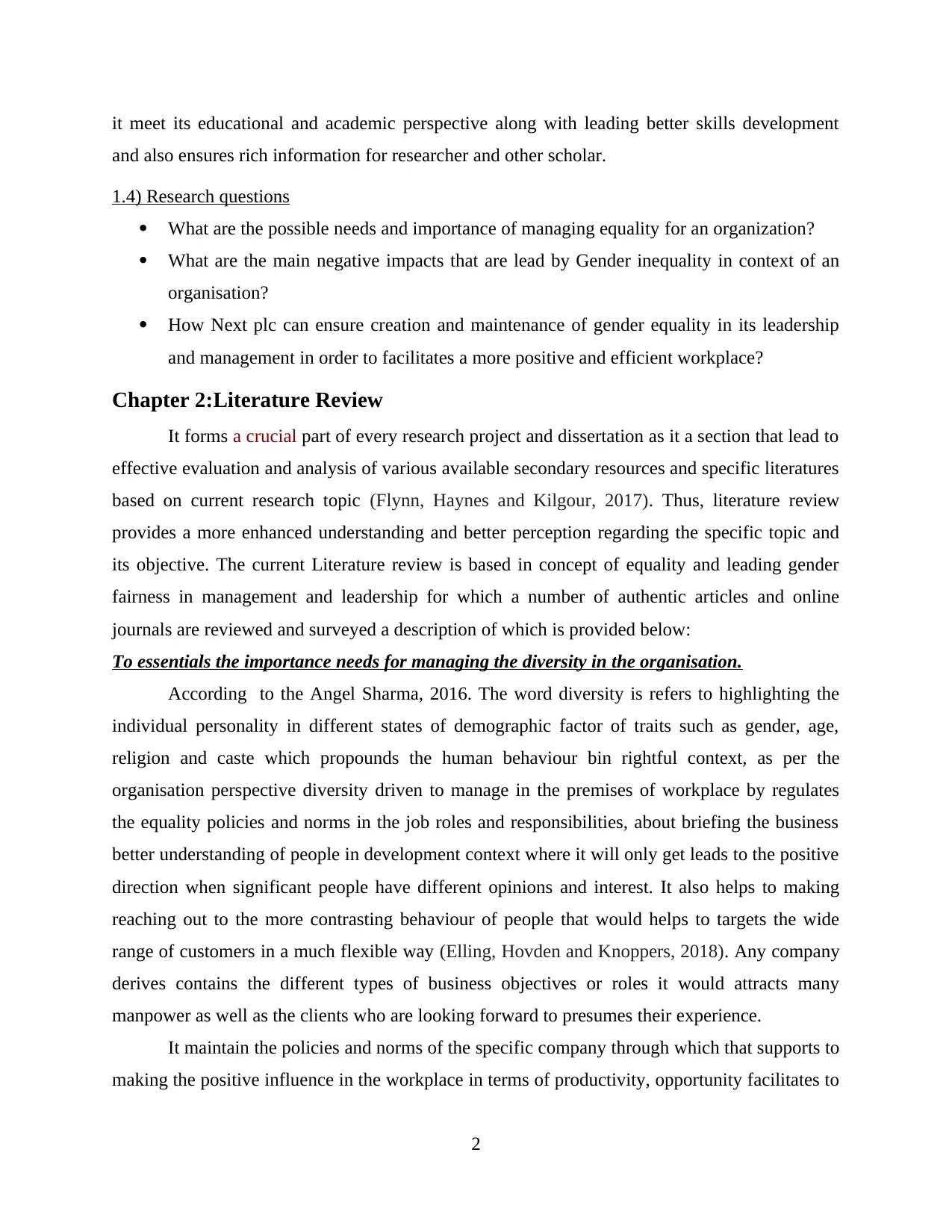
it meet its educational and academic perspective along with leading better skills development
and also ensures rich information for researcher and other scholar.
1.4) Research questions
What are the possible needs and importance of managing equality for an organization?
What are the main negative impacts that are lead by Gender inequality in context of an
organisation?
How Next plc can ensure creation and maintenance of gender equality in its leadership
and management in order to facilitates a more positive and efficient workplace?
Chapter 2:Literature Review
It forms a crucial part of every research project and dissertation as it a section that lead to
effective evaluation and analysis of various available secondary resources and specific literatures
based on current research topic (Flynn, Haynes and Kilgour, 2017). Thus, literature review
provides a more enhanced understanding and better perception regarding the specific topic and
its objective. The current Literature review is based in concept of equality and leading gender
fairness in management and leadership for which a number of authentic articles and online
journals are reviewed and surveyed a description of which is provided below:
To essentials the importance needs for managing the diversity in the organisation.
According to the Angel Sharma, 2016. The word diversity is refers to highlighting the
individual personality in different states of demographic factor of traits such as gender, age,
religion and caste which propounds the human behaviour bin rightful context, as per the
organisation perspective diversity driven to manage in the premises of workplace by regulates
the equality policies and norms in the job roles and responsibilities, about briefing the business
better understanding of people in development context where it will only get leads to the positive
direction when significant people have different opinions and interest. It also helps to making
reaching out to the more contrasting behaviour of people that would helps to targets the wide
range of customers in a much flexible way (Elling, Hovden and Knoppers, 2018). Any company
derives contains the different types of business objectives or roles it would attracts many
manpower as well as the clients who are looking forward to presumes their experience.
It maintain the policies and norms of the specific company through which that supports to
making the positive influence in the workplace in terms of productivity, opportunity facilitates to
2
and also ensures rich information for researcher and other scholar.
1.4) Research questions
What are the possible needs and importance of managing equality for an organization?
What are the main negative impacts that are lead by Gender inequality in context of an
organisation?
How Next plc can ensure creation and maintenance of gender equality in its leadership
and management in order to facilitates a more positive and efficient workplace?
Chapter 2:Literature Review
It forms a crucial part of every research project and dissertation as it a section that lead to
effective evaluation and analysis of various available secondary resources and specific literatures
based on current research topic (Flynn, Haynes and Kilgour, 2017). Thus, literature review
provides a more enhanced understanding and better perception regarding the specific topic and
its objective. The current Literature review is based in concept of equality and leading gender
fairness in management and leadership for which a number of authentic articles and online
journals are reviewed and surveyed a description of which is provided below:
To essentials the importance needs for managing the diversity in the organisation.
According to the Angel Sharma, 2016. The word diversity is refers to highlighting the
individual personality in different states of demographic factor of traits such as gender, age,
religion and caste which propounds the human behaviour bin rightful context, as per the
organisation perspective diversity driven to manage in the premises of workplace by regulates
the equality policies and norms in the job roles and responsibilities, about briefing the business
better understanding of people in development context where it will only get leads to the positive
direction when significant people have different opinions and interest. It also helps to making
reaching out to the more contrasting behaviour of people that would helps to targets the wide
range of customers in a much flexible way (Elling, Hovden and Knoppers, 2018). Any company
derives contains the different types of business objectives or roles it would attracts many
manpower as well as the clients who are looking forward to presumes their experience.
It maintain the policies and norms of the specific company through which that supports to
making the positive influence in the workplace in terms of productivity, opportunity facilitates to
2
⊘ This is a preview!⊘
Do you want full access?
Subscribe today to unlock all pages.

Trusted by 1+ million students worldwide
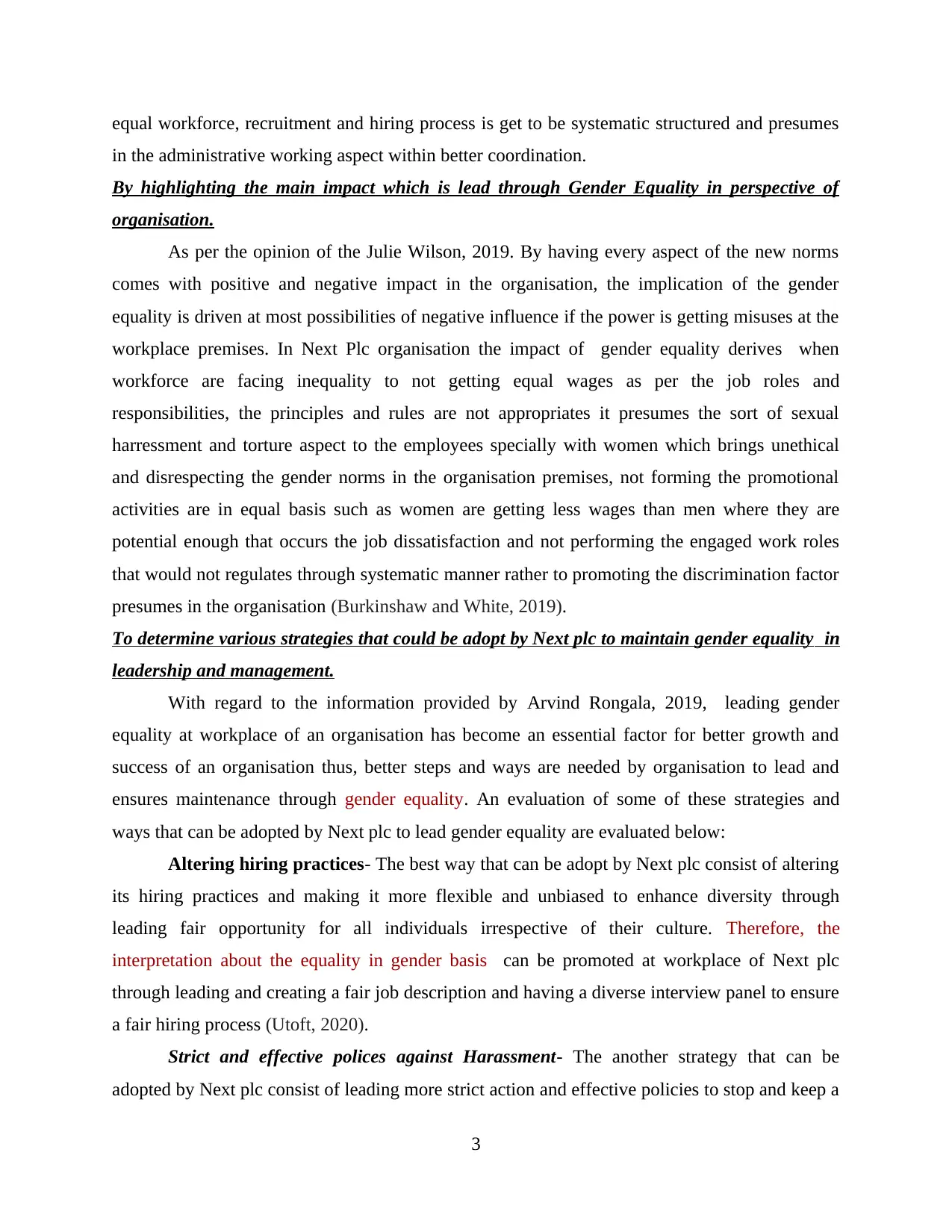
equal workforce, recruitment and hiring process is get to be systematic structured and presumes
in the administrative working aspect within better coordination.
By highlighting the main impact which is lead through Gender Equality in perspective of
organisation.
As per the opinion of the Julie Wilson, 2019. By having every aspect of the new norms
comes with positive and negative impact in the organisation, the implication of the gender
equality is driven at most possibilities of negative influence if the power is getting misuses at the
workplace premises. In Next Plc organisation the impact of gender equality derives when
workforce are facing inequality to not getting equal wages as per the job roles and
responsibilities, the principles and rules are not appropriates it presumes the sort of sexual
harressment and torture aspect to the employees specially with women which brings unethical
and disrespecting the gender norms in the organisation premises, not forming the promotional
activities are in equal basis such as women are getting less wages than men where they are
potential enough that occurs the job dissatisfaction and not performing the engaged work roles
that would not regulates through systematic manner rather to promoting the discrimination factor
presumes in the organisation (Burkinshaw and White, 2019).
To determine various strategies that could be adopt by Next plc to maintain gender equality in
leadership and management.
With regard to the information provided by Arvind Rongala, 2019, leading gender
equality at workplace of an organisation has become an essential factor for better growth and
success of an organisation thus, better steps and ways are needed by organisation to lead and
ensures maintenance through gender equality. An evaluation of some of these strategies and
ways that can be adopted by Next plc to lead gender equality are evaluated below:
Altering hiring practices- The best way that can be adopt by Next plc consist of altering
its hiring practices and making it more flexible and unbiased to enhance diversity through
leading fair opportunity for all individuals irrespective of their culture. Therefore, the
interpretation about the equality in gender basis can be promoted at workplace of Next plc
through leading and creating a fair job description and having a diverse interview panel to ensure
a fair hiring process (Utoft, 2020).
Strict and effective polices against Harassment- The another strategy that can be
adopted by Next plc consist of leading more strict action and effective policies to stop and keep a
3
in the administrative working aspect within better coordination.
By highlighting the main impact which is lead through Gender Equality in perspective of
organisation.
As per the opinion of the Julie Wilson, 2019. By having every aspect of the new norms
comes with positive and negative impact in the organisation, the implication of the gender
equality is driven at most possibilities of negative influence if the power is getting misuses at the
workplace premises. In Next Plc organisation the impact of gender equality derives when
workforce are facing inequality to not getting equal wages as per the job roles and
responsibilities, the principles and rules are not appropriates it presumes the sort of sexual
harressment and torture aspect to the employees specially with women which brings unethical
and disrespecting the gender norms in the organisation premises, not forming the promotional
activities are in equal basis such as women are getting less wages than men where they are
potential enough that occurs the job dissatisfaction and not performing the engaged work roles
that would not regulates through systematic manner rather to promoting the discrimination factor
presumes in the organisation (Burkinshaw and White, 2019).
To determine various strategies that could be adopt by Next plc to maintain gender equality in
leadership and management.
With regard to the information provided by Arvind Rongala, 2019, leading gender
equality at workplace of an organisation has become an essential factor for better growth and
success of an organisation thus, better steps and ways are needed by organisation to lead and
ensures maintenance through gender equality. An evaluation of some of these strategies and
ways that can be adopted by Next plc to lead gender equality are evaluated below:
Altering hiring practices- The best way that can be adopt by Next plc consist of altering
its hiring practices and making it more flexible and unbiased to enhance diversity through
leading fair opportunity for all individuals irrespective of their culture. Therefore, the
interpretation about the equality in gender basis can be promoted at workplace of Next plc
through leading and creating a fair job description and having a diverse interview panel to ensure
a fair hiring process (Utoft, 2020).
Strict and effective polices against Harassment- The another strategy that can be
adopted by Next plc consist of leading more strict action and effective policies to stop and keep a
3
Paraphrase This Document
Need a fresh take? Get an instant paraphrase of this document with our AI Paraphraser
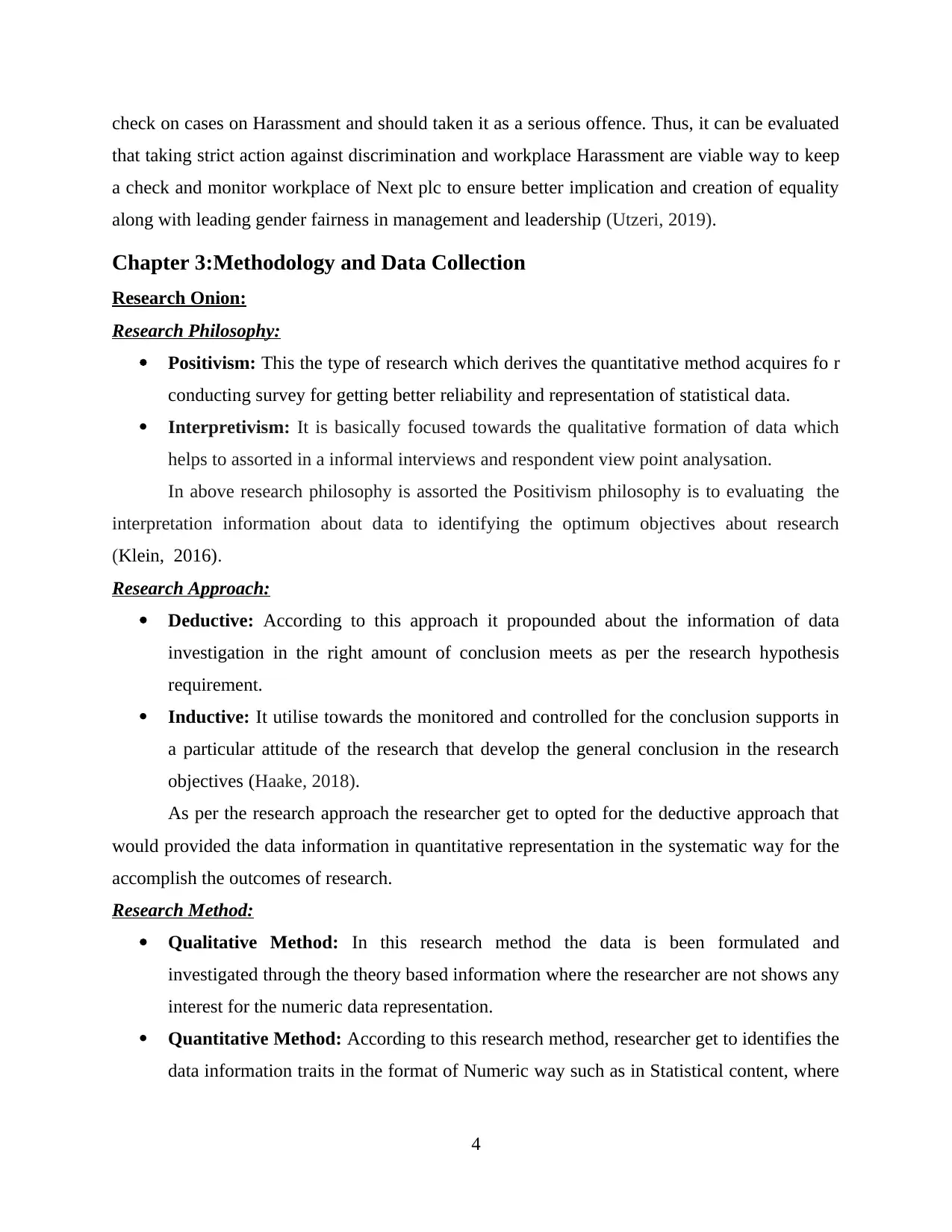
check on cases on Harassment and should taken it as a serious offence. Thus, it can be evaluated
that taking strict action against discrimination and workplace Harassment are viable way to keep
a check and monitor workplace of Next plc to ensure better implication and creation of equality
along with leading gender fairness in management and leadership (Utzeri, 2019).
Chapter 3:Methodology and Data Collection
Research Onion:
Research Philosophy:
Positivism: This the type of research which derives the quantitative method acquires fo r
conducting survey for getting better reliability and representation of statistical data.
Interpretivism: It is basically focused towards the qualitative formation of data which
helps to assorted in a informal interviews and respondent view point analysation.
In above research philosophy is assorted the Positivism philosophy is to evaluating the
interpretation information about data to identifying the optimum objectives about research
(Klein, 2016).
Research Approach:
Deductive: According to this approach it propounded about the information of data
investigation in the right amount of conclusion meets as per the research hypothesis
requirement.
Inductive: It utilise towards the monitored and controlled for the conclusion supports in
a particular attitude of the research that develop the general conclusion in the research
objectives (Haake, 2018).
As per the research approach the researcher get to opted for the deductive approach that
would provided the data information in quantitative representation in the systematic way for the
accomplish the outcomes of research.
Research Method:
Qualitative Method: In this research method the data is been formulated and
investigated through the theory based information where the researcher are not shows any
interest for the numeric data representation.
Quantitative Method: According to this research method, researcher get to identifies the
data information traits in the format of Numeric way such as in Statistical content, where
4
that taking strict action against discrimination and workplace Harassment are viable way to keep
a check and monitor workplace of Next plc to ensure better implication and creation of equality
along with leading gender fairness in management and leadership (Utzeri, 2019).
Chapter 3:Methodology and Data Collection
Research Onion:
Research Philosophy:
Positivism: This the type of research which derives the quantitative method acquires fo r
conducting survey for getting better reliability and representation of statistical data.
Interpretivism: It is basically focused towards the qualitative formation of data which
helps to assorted in a informal interviews and respondent view point analysation.
In above research philosophy is assorted the Positivism philosophy is to evaluating the
interpretation information about data to identifying the optimum objectives about research
(Klein, 2016).
Research Approach:
Deductive: According to this approach it propounded about the information of data
investigation in the right amount of conclusion meets as per the research hypothesis
requirement.
Inductive: It utilise towards the monitored and controlled for the conclusion supports in
a particular attitude of the research that develop the general conclusion in the research
objectives (Haake, 2018).
As per the research approach the researcher get to opted for the deductive approach that
would provided the data information in quantitative representation in the systematic way for the
accomplish the outcomes of research.
Research Method:
Qualitative Method: In this research method the data is been formulated and
investigated through the theory based information where the researcher are not shows any
interest for the numeric data representation.
Quantitative Method: According to this research method, researcher get to identifies the
data information traits in the format of Numeric way such as in Statistical content, where
4
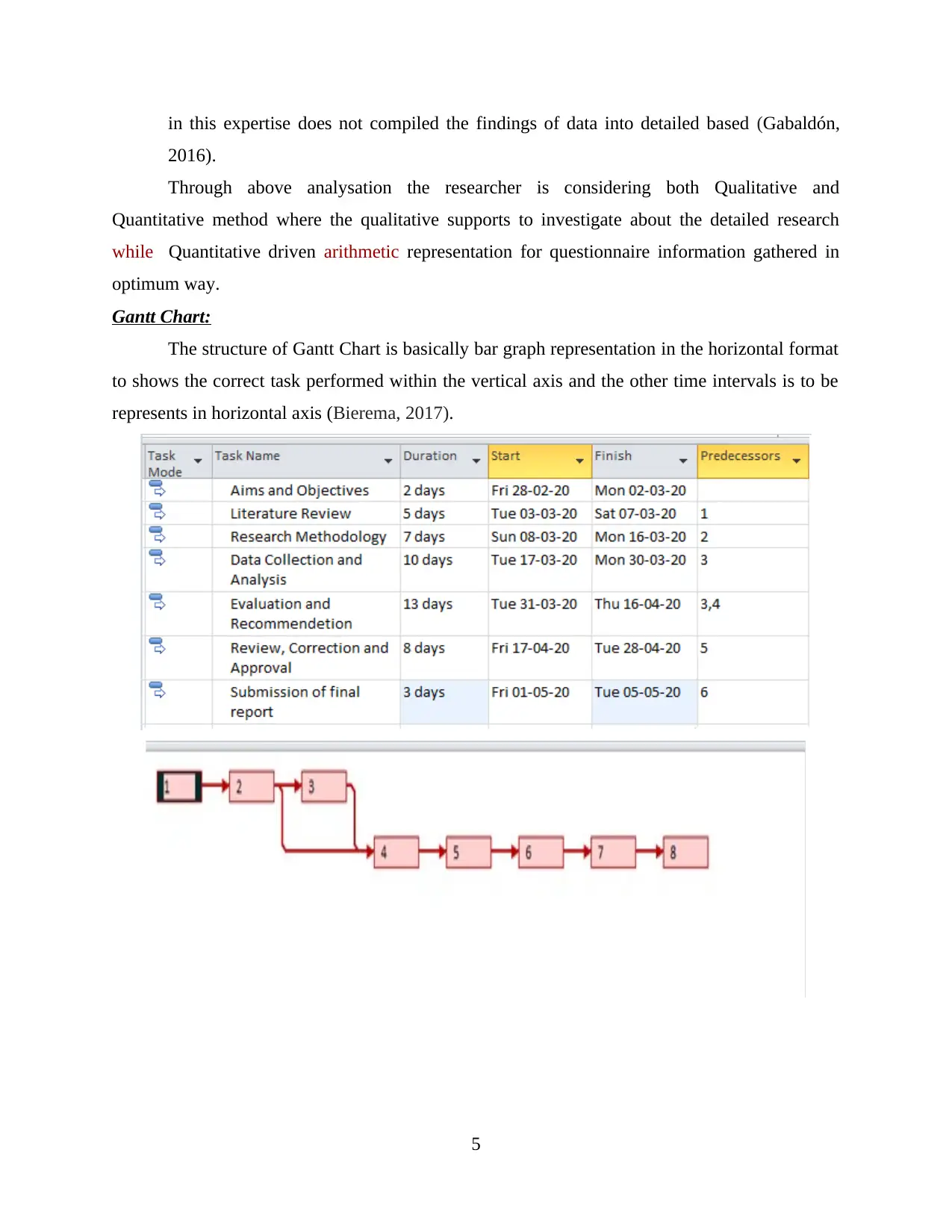
in this expertise does not compiled the findings of data into detailed based (Gabaldón,
2016).
Through above analysation the researcher is considering both Qualitative and
Quantitative method where the qualitative supports to investigate about the detailed research
while Quantitative driven arithmetic representation for questionnaire information gathered in
optimum way.
Gantt Chart:
The structure of Gantt Chart is basically bar graph representation in the horizontal format
to shows the correct task performed within the vertical axis and the other time intervals is to be
represents in horizontal axis (Bierema, 2017).
5
2016).
Through above analysation the researcher is considering both Qualitative and
Quantitative method where the qualitative supports to investigate about the detailed research
while Quantitative driven arithmetic representation for questionnaire information gathered in
optimum way.
Gantt Chart:
The structure of Gantt Chart is basically bar graph representation in the horizontal format
to shows the correct task performed within the vertical axis and the other time intervals is to be
represents in horizontal axis (Bierema, 2017).
5
⊘ This is a preview!⊘
Do you want full access?
Subscribe today to unlock all pages.

Trusted by 1+ million students worldwide
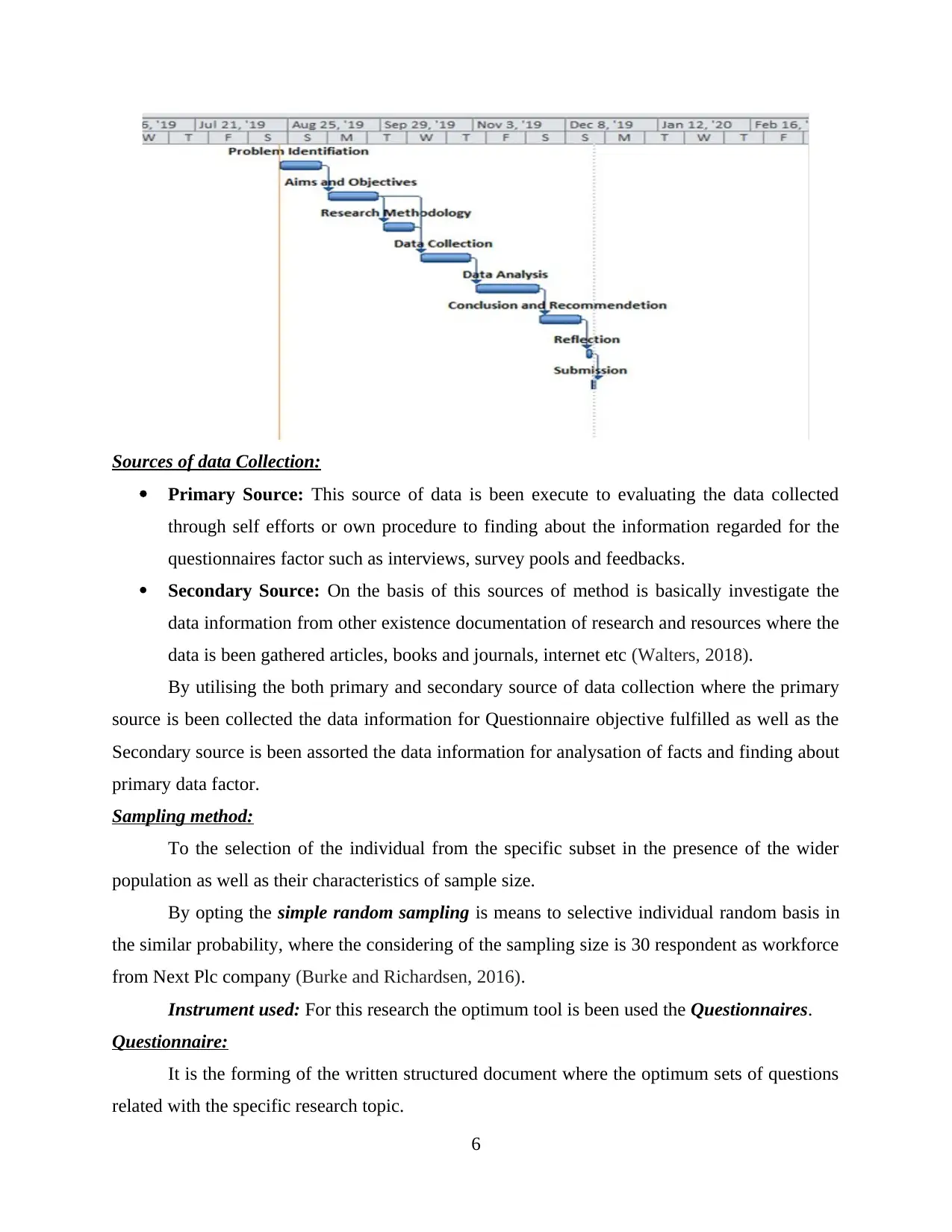
Sources of data Collection:
Primary Source: This source of data is been execute to evaluating the data collected
through self efforts or own procedure to finding about the information regarded for the
questionnaires factor such as interviews, survey pools and feedbacks.
Secondary Source: On the basis of this sources of method is basically investigate the
data information from other existence documentation of research and resources where the
data is been gathered articles, books and journals, internet etc (Walters, 2018).
By utilising the both primary and secondary source of data collection where the primary
source is been collected the data information for Questionnaire objective fulfilled as well as the
Secondary source is been assorted the data information for analysation of facts and finding about
primary data factor.
Sampling method:
To the selection of the individual from the specific subset in the presence of the wider
population as well as their characteristics of sample size.
By opting the simple random sampling is means to selective individual random basis in
the similar probability, where the considering of the sampling size is 30 respondent as workforce
from Next Plc company (Burke and Richardsen, 2016).
Instrument used: For this research the optimum tool is been used the Questionnaires.
Questionnaire:
It is the forming of the written structured document where the optimum sets of questions
related with the specific research topic.
6
Primary Source: This source of data is been execute to evaluating the data collected
through self efforts or own procedure to finding about the information regarded for the
questionnaires factor such as interviews, survey pools and feedbacks.
Secondary Source: On the basis of this sources of method is basically investigate the
data information from other existence documentation of research and resources where the
data is been gathered articles, books and journals, internet etc (Walters, 2018).
By utilising the both primary and secondary source of data collection where the primary
source is been collected the data information for Questionnaire objective fulfilled as well as the
Secondary source is been assorted the data information for analysation of facts and finding about
primary data factor.
Sampling method:
To the selection of the individual from the specific subset in the presence of the wider
population as well as their characteristics of sample size.
By opting the simple random sampling is means to selective individual random basis in
the similar probability, where the considering of the sampling size is 30 respondent as workforce
from Next Plc company (Burke and Richardsen, 2016).
Instrument used: For this research the optimum tool is been used the Questionnaires.
Questionnaire:
It is the forming of the written structured document where the optimum sets of questions
related with the specific research topic.
6
Paraphrase This Document
Need a fresh take? Get an instant paraphrase of this document with our AI Paraphraser
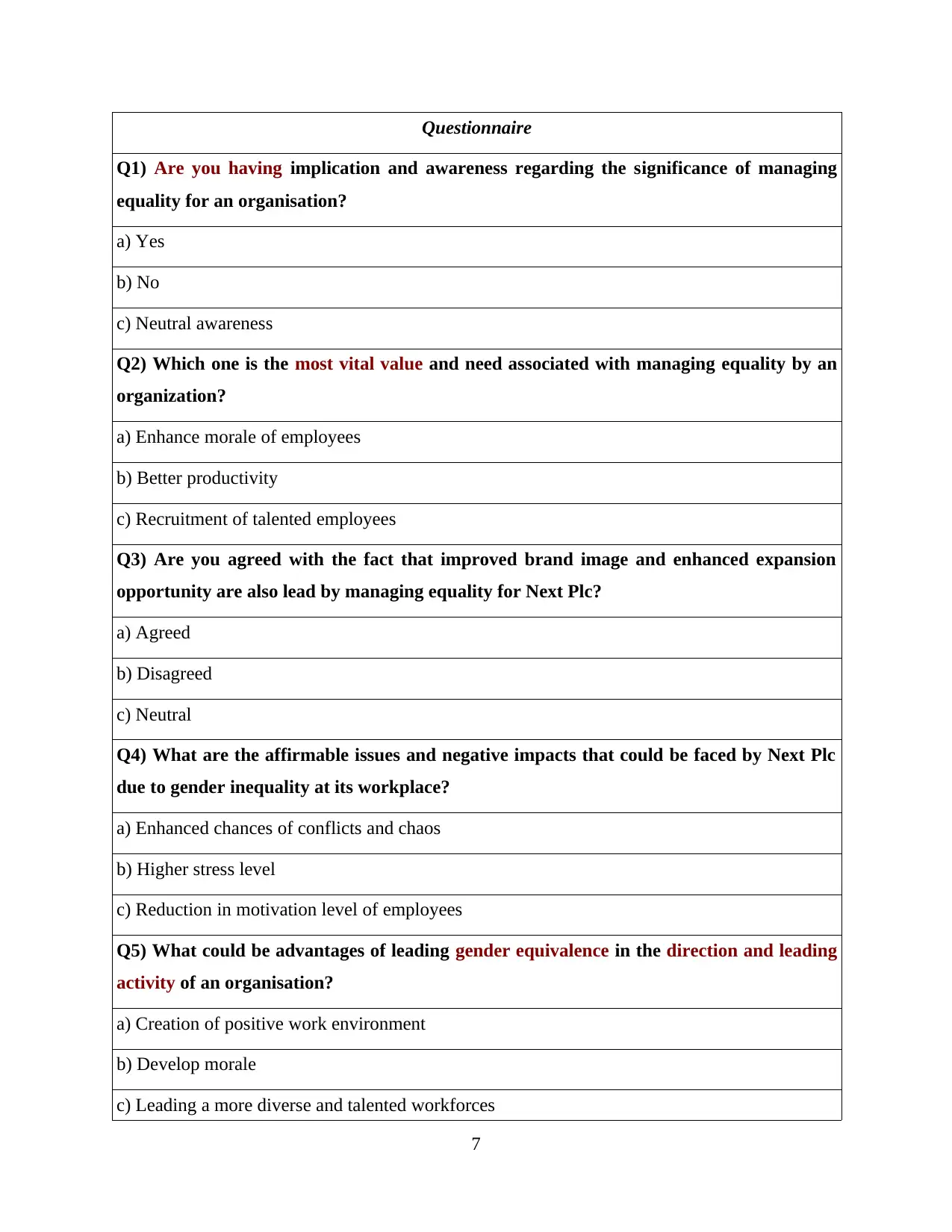
Questionnaire
Q1) Are you having implication and awareness regarding the significance of managing
equality for an organisation?
a) Yes
b) No
c) Neutral awareness
Q2) Which one is the most vital value and need associated with managing equality by an
organization?
a) Enhance morale of employees
b) Better productivity
c) Recruitment of talented employees
Q3) Are you agreed with the fact that improved brand image and enhanced expansion
opportunity are also lead by managing equality for Next Plc?
a) Agreed
b) Disagreed
c) Neutral
Q4) What are the affirmable issues and negative impacts that could be faced by Next Plc
due to gender inequality at its workplace?
a) Enhanced chances of conflicts and chaos
b) Higher stress level
c) Reduction in motivation level of employees
Q5) What could be advantages of leading gender equivalence in the direction and leading
activity of an organisation?
a) Creation of positive work environment
b) Develop morale
c) Leading a more diverse and talented workforces
7
Q1) Are you having implication and awareness regarding the significance of managing
equality for an organisation?
a) Yes
b) No
c) Neutral awareness
Q2) Which one is the most vital value and need associated with managing equality by an
organization?
a) Enhance morale of employees
b) Better productivity
c) Recruitment of talented employees
Q3) Are you agreed with the fact that improved brand image and enhanced expansion
opportunity are also lead by managing equality for Next Plc?
a) Agreed
b) Disagreed
c) Neutral
Q4) What are the affirmable issues and negative impacts that could be faced by Next Plc
due to gender inequality at its workplace?
a) Enhanced chances of conflicts and chaos
b) Higher stress level
c) Reduction in motivation level of employees
Q5) What could be advantages of leading gender equivalence in the direction and leading
activity of an organisation?
a) Creation of positive work environment
b) Develop morale
c) Leading a more diverse and talented workforces
7
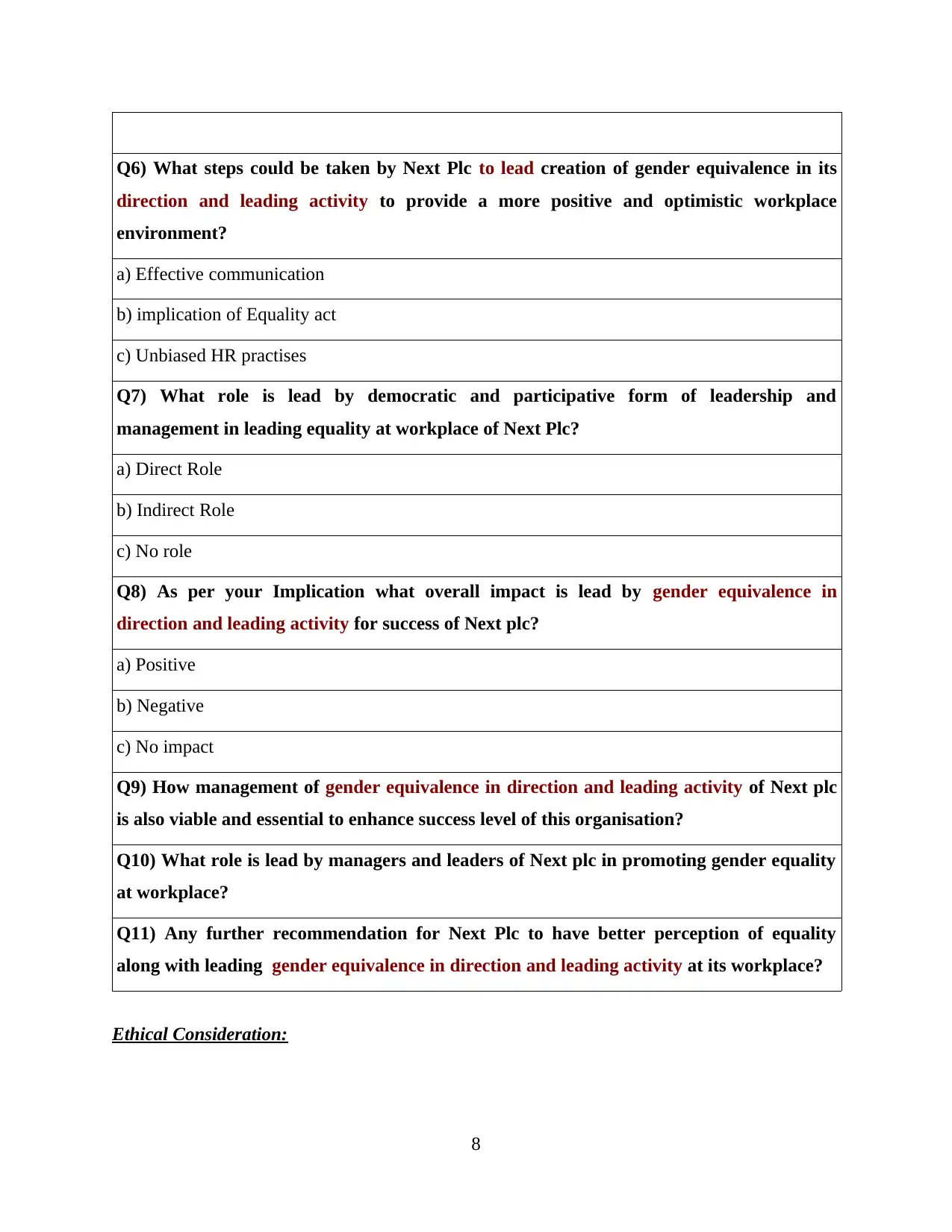
Q6) What steps could be taken by Next Plc to lead creation of gender equivalence in its
direction and leading activity to provide a more positive and optimistic workplace
environment?
a) Effective communication
b) implication of Equality act
c) Unbiased HR practises
Q7) What role is lead by democratic and participative form of leadership and
management in leading equality at workplace of Next Plc?
a) Direct Role
b) Indirect Role
c) No role
Q8) As per your Implication what overall impact is lead by gender equivalence in
direction and leading activity for success of Next plc?
a) Positive
b) Negative
c) No impact
Q9) How management of gender equivalence in direction and leading activity of Next plc
is also viable and essential to enhance success level of this organisation?
Q10) What role is lead by managers and leaders of Next plc in promoting gender equality
at workplace?
Q11) Any further recommendation for Next Plc to have better perception of equality
along with leading gender equivalence in direction and leading activity at its workplace?
Ethical Consideration:
8
direction and leading activity to provide a more positive and optimistic workplace
environment?
a) Effective communication
b) implication of Equality act
c) Unbiased HR practises
Q7) What role is lead by democratic and participative form of leadership and
management in leading equality at workplace of Next Plc?
a) Direct Role
b) Indirect Role
c) No role
Q8) As per your Implication what overall impact is lead by gender equivalence in
direction and leading activity for success of Next plc?
a) Positive
b) Negative
c) No impact
Q9) How management of gender equivalence in direction and leading activity of Next plc
is also viable and essential to enhance success level of this organisation?
Q10) What role is lead by managers and leaders of Next plc in promoting gender equality
at workplace?
Q11) Any further recommendation for Next Plc to have better perception of equality
along with leading gender equivalence in direction and leading activity at its workplace?
Ethical Consideration:
8
⊘ This is a preview!⊘
Do you want full access?
Subscribe today to unlock all pages.

Trusted by 1+ million students worldwide
1 out of 27
Related Documents
Your All-in-One AI-Powered Toolkit for Academic Success.
+13062052269
info@desklib.com
Available 24*7 on WhatsApp / Email
![[object Object]](/_next/static/media/star-bottom.7253800d.svg)
Unlock your academic potential
Copyright © 2020–2025 A2Z Services. All Rights Reserved. Developed and managed by ZUCOL.





